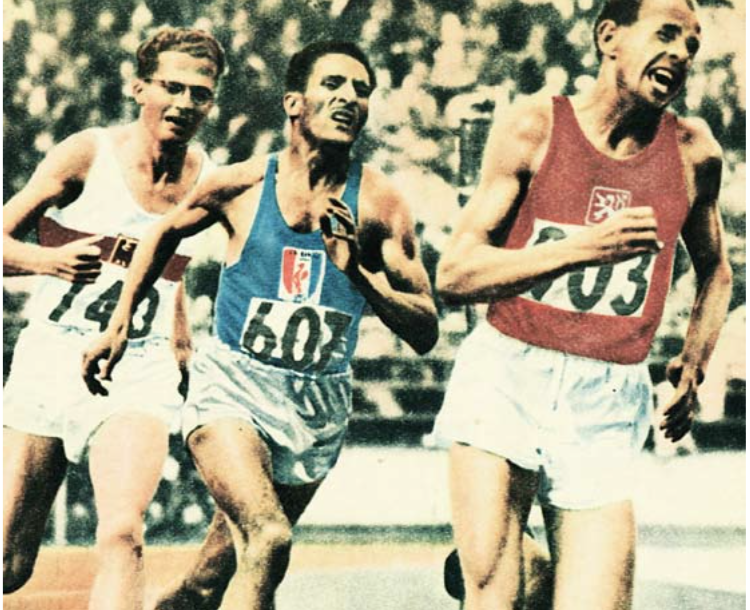The saga of the great Czech distance runner is recounted in a book by the Rai journalist Marco Franzelli

Three Olympic Games, countless medals, a great love and a dream. A woman named Dana, an athlete who was born on the same day, the same month and the same year as him. A love that was born on the racetracks and that accompanied him faithfully throughout his life: Emil Zatopek from Koprivnice was, after all, a fortunate man. Even ten years after his death, the epic story of Emil Zatopek, the athlete runner, the so called “human locomotive”, the “Leopard man”, the athlete-worker who had been employed in the Bata shoe factory in Zlin, still enthrals generations of sports fans.
Zatopek was and will remain the athlete who won three consecutive victories in the 1948 Olympics in London, Helsinki in 1952 and Melbourne in 1956; extraordinary achievements in the five thousand and ten thousand meters and in the marathon at the Olympic Games of Helsinki in 1952. The self-made sportsman was famous for his gruelling workouts in the woods under very cold weather conditions, his slightly naive technique, but mostly for his absolute determination to succeed. A fact that allowed him to hold an almost 10 year-long athletic record. His rather unfortunate, but powerful rivals, were Heino from Finland, the American Wooderson, the Belgian Reiff and German Schade.
Gianni Brera once wrote: “Zatopek was the athlete who taught us that man’s resources are infinite and can reach any objective, as long as he knows how to struggle and suffer to achieve it…”.
It is a fact: after his humble beginnings as a factory worker at Bata and the long list of victories on the racetrack, his name soon reached the attention of the sports media. Zatopek was soon to become the records ambassador of the People’s Democratic Republic of Klement Gottwald. The icon (conscious or naive?) of Communist excellence during most of the Cold War period. He also, in fact, made a very fast career in the army and reached the rank of colonel, and ran in most of the stadiums and racetracks around Europe, signing thousands of autographs and, deservedly, hitting the headlines of the press and media as a real star. Yet, behind his triumphs, the headlines, the films and general acclamation, Emil had always managed to maintain a human dimension, despite his “invincible” appearance. As shown by his friendship with the French competitor Mimoun, the eternal second, nicknamed the “Silver Ghost”, the man who remained loyal to him during his sportive decline in 1958 and his withdrawal from this activity after well over seventeen years – which is also an achievement in itself for this “record” man.

As described in the book by the Rai journalist Mark Franzelli written in a fluent style, (“Zatopek, the human locomotive”, biancoenero editions, 160 pages at 14 euro), Emil had learned to win, but never forgot who he really was and how he intended to stay: a patriot, but at the same time, a protagonist of the critical choices he made during his glorious life.
Having become a national hero, director of sports activities at the Ministry of Defence, he did not hesitate to take sides in favour of the 1968 Prague Spring and signed the famous “Two thousand words” manifesto. No exceptional exploit for those who really knew him: Emil Zatopek was used to facing the consequences of his actions and knew how to bear with dignity the cost of his political choices. In fact, after being expelled from the army and the party and becoming unemployed, he then worked as a miner in the uranium mines in Jachymov on the border with Germany: “By reconting his life – Franzelli goes on to say – I wanted to offer young people the opportunity to read about the glories of a great sportsman, but also to delve into over fifty years of European history: from the post-war period to the fall of the Berlin Wall.”
The rehabilitation of the hero, who wore sneakers, took place only after the fall of the communist regimes: from 1990 to the year 2000, a decade during which Zatopek became once more the ambassador for sport in many stadiums around the world. However, fading into oblivion, which normally affects famous characters, was not true for Zatopek, even after his death. Thanks to his exceptional success, extraordinary endurance and fast accelerations, the Moravian long-distance runner is still today an indelible sport icon. Not only in Prague, but throughout Europe: We still refer to a period as being “before Zatopek” and “after Zatopek”, Franzelli points out. We may say quite safely that the Moravian runner played a fundamental role in changing the style of athletics, by adding elements of modernization and innovation that would have otherwise been unthinkable in the past. One of these, being the famous “repeated” accelerations of pace during the race – that made him invincible”.
However, the other distinguishing element that will remain vivid in everybody’s memory is the hard painful expressions that marked Emil’s face during the competition. A grimace that was at times unpleasant to see, with an apparently uncoordinated running style, and an inelegant stride: all real elements which, however, did not prevent dozens of champions from paying tribute to his supremacy, because the racetrack caused him great suffering and he also cried at times. But, Emil Zatopek (the locomotive) knew exactly how to win, as nobody else had been able to.
By Ernesto Massimetti




